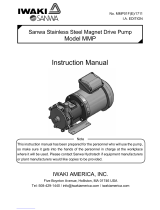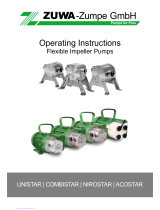
10
Motor/Electrical
Install the motor according to NEC requirements and local
electrical codes. The motor should have an overload pro-
tection circuit.
Wire the motor for clockwise rotation when facing the fan end
of the motor.
CAUTION: Do not operate the pump to check rotation
until the pump is full of liquid.
Check all electrical connections with the wiring diagram on
the motor. Make sure the voltage, frequency, phase and amp
draw comply with the supply circuit.
If utilized, verify that the power monitor has been properly
installed according to the manufacturers instructions.
To verify correct rotation of the motor:
1. Install the pump into the system.
2. Fully open the suction and discharge valves.
3. Allow fluid to flow into the pump. Do not allow the pump
to run dry (ceramic, PTFE and silicon carbide bushings
can’t be run dry without damage to pump components).
4. Jog the motor (allow it to run for 1-2 seconds) and
observe the rotation of the motor fan. Refer to the direc-
tional arrow molded into the pump casing if necessary.
NOTE: A pump running backwards will pump but at a greatly
reduced flow and pressure.
1. This pump must be filled from a flooded suction tank (gravity)
or primed with liquid from an outside source. The DB11/15 is
not self-priming.
2. Open the inlet (suction) and discharge valves completely and
allow the pump to fill with liquid.
3. Close the discharge valve.
4. Turn the pump on. Slowly open the discharge valve. Adjust
the flow rate and pressure by regulating the discharge valve.
Flush Systems
CAUTION: Some fluids react with water; use compatible
flushing fluid.
1. Turn off the pump.
2. Completely close the suction and discharge valves.
3. Connect flushing fluid supply to flush inlet valve.
4. Connect flushing fluid drain to flush drain valve.
5. Open flushing inlet and outlet valves. Flush system until
the pump is clean.
Optional Drain Installation
1. Remove the impeller housing from the pump assembly.
2. Clamp the impeller housing to a drill press table.
3. Using a 7/16” drill and the molded boss as a guide, drill
completely through the molded boss into the interior of
the impeller housing. De-burr the hole on the inside of the
impeller housing.
CAUTION - Do not tap too deep or the impeller housing may
be damaged.
4. Using a 1/4” NPT tap, tap the hole in the molded boss
to the appropriate depth.
5. Install the drain plug or valve, being careful not to
overtighten.
Section IV - Maintenance
Recommended maintenance schedule
The recommended maintenance schedule depends upon the na-
ture of the fluid being pumped and the specific application. If the
pump is used on a clean fluid, it is recommended that the pump
be removed from service and examined after six months of
operation or after 2,000 hours of operation. If the pump is used
on fluids with solids, high temperatures or other items that could
cause accelerated wear, then this initial examination should be
sooner.
After the initial examination of the internal components and wear
items are measured, a specific maintenance schedule can be
determined. For best results, it is recommended that the pump
be removed from service annually for examination.
Section III - Start-up and Operation
Shutdown
Use the following procedure to shutdown the pump.
1. Slowly close the discharge valve.
2. Turn off the motor.
3. Close the suction valve.
Do not attempt to adjust the flow with the suction valve.
5. Use of a power monitor is strongly recommended for pumps
with ceramic, PTFE or silicon carbide bushings. The power
monitor will stop the pump and help prevent damage if the
pump should run dry. ATEX certified pumps MUST use a
power monitor.
• FTI advises installing a flush system in the piping to allow
the pump to be flushed before it is removed from service.
NOTE: The pump is provided with a provision for a
customer installed ¼” drain in the impeller housing. See
the Drain Installation Section for details.
• For units in a suction lift system, install appropriate piping
in the discharge to allow priming of the pump (DB11/15
models are not self-priming).
• When installing pumps with flanges, we recommend use of
low seating stress gaskets such as Gore-Tex® or Gylon®
(expanded PTFE).






















